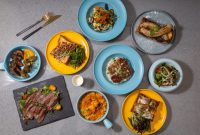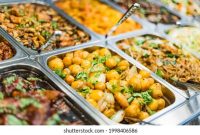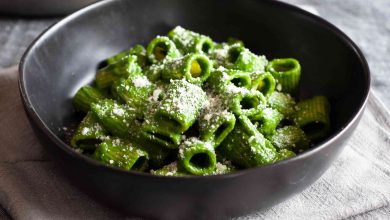The best corners with Indian food in Moscow markets and food halls
There are very few good restaurants with real Indian cuisine in Moscow, unlike, say, New York or London. But with the sudden increase in the number of food halls in the capital, our chances of eating real Palak paneer or chi ken tikka masala have increased dramatically. Time Out toured the best Indian food corners and shares the details.
“Turmeric Bollywood”
A team of Indian chefs led by Chef Surrender Singh is in charge of the Turmeric cuisine. Originally from northern India, he has worked in restaurants in Delhi and has lived in Moscow for the past 12 years. Everything is very serious: they chant mantras in the kitchen and regularly arrange Indian days for guests with tarot reading and master classes on making cakes. A special pride is the real Indian tandoori oven, where chicken, cheese and whole fish are baked. The most authentic cuisine is packed in a European format – the corners look bright, minimalistic and quite in the spirit of the times.
The detailed menu contains all the colors of classic Indian street food. Take Rishikesh Manchuria (330 rubles) – vegetable meatballs in batter in a spicy sweet and sour sauce – or Afghani chi ken (490 rubles), for which the chicken is marinated in yogurt sauce with spices and cashews, and then sent to the oven. In the afternoon, lunches are served on iron trays with Palak paneer and lentil soup according to a textbook northern recipe, rice, a couple of flatbreads and four types of curries to choose from (340-520 rubles). And you need to drink everything with the legendary masala tea (100 rubles) – a dense, sweet, spicy and slightly tangy drink made with cow’s milk.

In the new gastronomic space Tashima Gastro Hall, the first corner under the name “Indus” has opened. The concept was combed into a restaurant format: guests are brought free water, and food is served on plates. After working for several years in London, Paris and Berlin, chef Milan Lukovchan came to Moscow to take Indian food to the next level. Cleverly placing accents, he adds seafood, Indian cheeses and original sauces (they are served to almost every dish) to the textbook spices, cereals, legumes and chicken.
The menu has a large selection of curries, including a chickpea vegan cholla curry (480 rubles), an impressive chapter with seafood, including tikka king prawns in masala coconut sauce (700 rubles), and a tandoori section: chicken, mushrooms and cheese are simmered in the eponymous clay oven … Try the Malay tikka (650 rubles) – marinated chicken pieces in cream and cashews: the portion is large, the pleasure is unsullied. Tandoori seabass hiding under the name fish tikka (750 rubles) is also a must for tasting. Breakfasts are spelled out in a separate line, so if you find yourself next to the “Indians” in the morning, order vegan masala tea (165 rubles) and Khiri pure (280 rubles) – sweet rice pudding made with milk with raisins, spices, ginger and two banana cakes in addition.
“Caution, elephant!”
To the project “Caution, elephant!” three and a half years. During this time, he went from a tiny shop with a four-course menu to two full-fledged corners. From the point of view of appearance, there is no authenticity: no one burns incense or lays the floor with tiles with a national ornament. Food is prepared according to traditional recipes, but each dish is interpreted in a modern way, for example, samosas (in the original version – fried dough triangles stuffed with potatoes and green peas) are served with different fillings: in summer with strawberries, in autumn with baked apples or with beans and cheddar cheese, and in winter – a spoiler! – will be cherry (all 150 rubles).

The compulsory program includes Palak paneer (320 rubles), for which homemade cheese is fried here in a spicy spinach sauce, and a bowl of rice is sent to it as a side dish. “Elephant” is also proud of its salty lassi (130 rubles) – a kefir neck with mint sauce, fried cumin and pink salt, which gives the drink a bright “volcanic” aftertaste. But the main local feature is the hoist. In India, this word is used to describe an ordinary dinner, collected on one roomy plate according to the principle “what is found, that is what they are glad to do”. In “Beware, Elephant!” Tail is available in different sizes: they are prepared from a classic lunch (with a flat cake, rice, a couple of snacks and, at your choice, hot or dessert) to a giant tray on which almost all dishes from the menu are collected in a tasting set.
Dabbawalla
The Dabbawalla concept was developed by Arum Nanda, a Hindu who has lived in Russia since childhood and has an understandable longing for his historical homeland. To open his project, he traveled to different states of India in search of traditional recipes. The name is in honor of the Indian hot meal delivery service, which delivers food despite all the cataclysms: a strike, a national holiday, and even a hurricane. Dabbawalla in Moscow is stylized with all the appropriate flavor corners with cereals and spices straight from India, Indian chefs and an attentive attitude to vegetarians: almost all dishes here can be replayed in a vegetarian way.
The menu is conventionally divided into two parts: a denser meat one – here the cuisine of the northern part of the country is cited, where chicken and lamb are mainly cooked, and a vegetarian one, which is inherent in the southern part. The choice is large: there are four different options for pilaf biryani alone. But first of all, be sure to try chi ken tikka masala (590 rubles) – a sirloin of chicken thigh baked in tandoori, which is buried in a rich tomato sauce with spices: garam masala, cumin, paprika, garlic and ginger root. The vegetarian alternative with cheese – paneer tikka masala (560 rubles) – tastes almost indistinguishable from the meat version.



